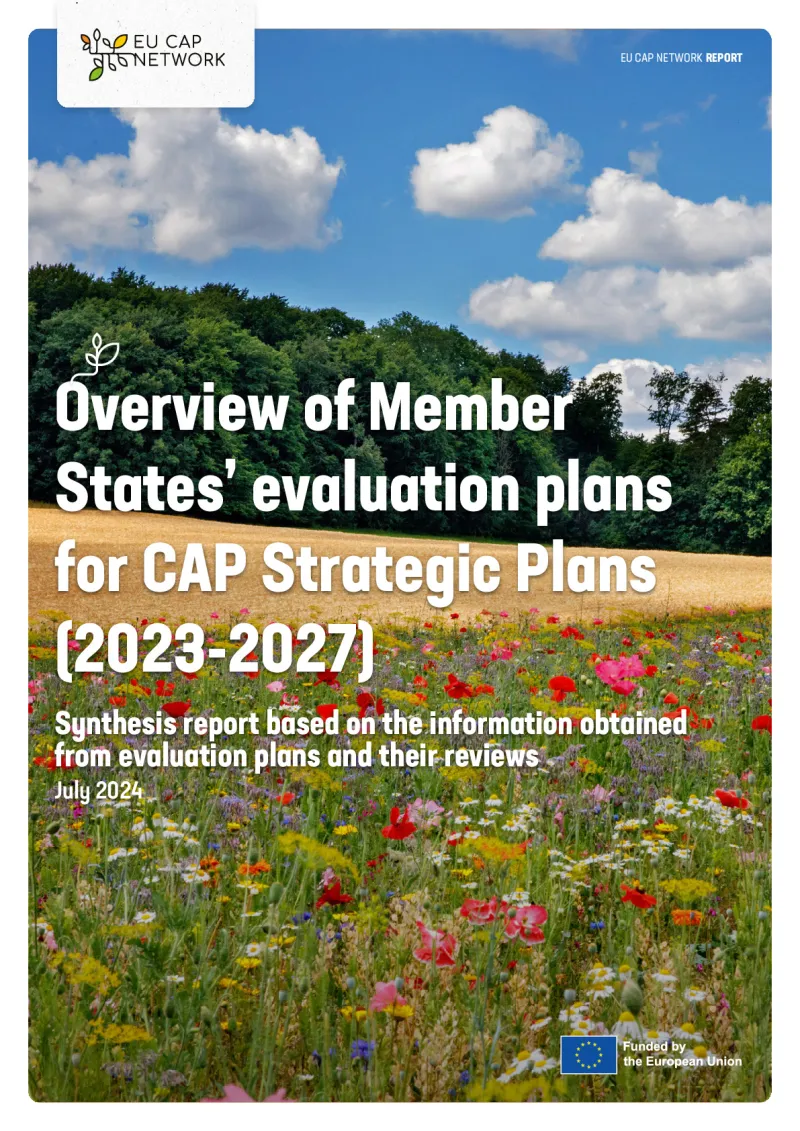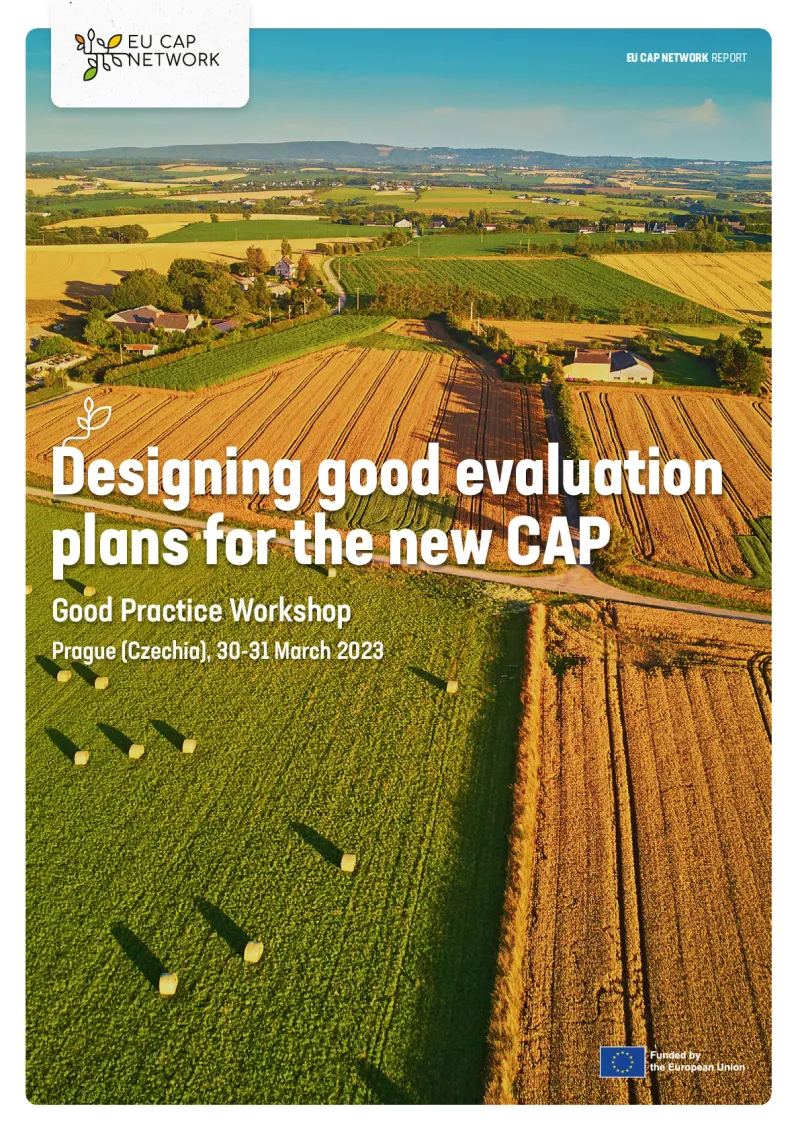Overview of Member States’ evaluation plans for CAP Strategic Plans (2023-2027)
- Evaluation
- Evaluation Plan
- CAP Strategic Plans
- Environment
- LEADER
- AKIS
- Evaluation
- Fostering Knowledge & Innovation
This report synthesises 28 evaluation plans by Member States for their CAP Strategic Plans (2023-2027). These plans are practical, living documents outlining evaluation activities during the CAP implementation.
- 2023-2027
- Cross-cutting impacts


This synthesis report summarises the key features of 28 evaluation plans, offering an overview of the ambitions of Member States concerning CAP Strategic Plans’ evaluations. It provides baseline and contextual information for subsequent evaluations to be carried out during the 2023-2027 period, and serves as a reference for Member States to share their plans and learn from one another's experiences. Moreover, the report identifies and highlights good practices observed in various sections of the evaluation plans (EPs).
Evaluation plans, developed by Member States under the guidance of their Managing Authorities and presented to their respective Monitoring Committees, aim to outline the evaluation activities that will be undertaken during the implementation of the CAP Strategic Plans (2023-2027).
The primary purpose of these EPs is to ensure that sufficient and appropriate evaluations are conducted to provide the necessary information for program steering, to inform future policy periods, and to ensure that the data required for CAP Strategic Plans evaluations are available. The evaluation plans cover seven key categories as defined by the Implementing Regulation (EU) 2022/1475: Objectives and needs; Governance and coordination; Stakeholder mapping; Timeline; Data and information; Communication and follow-up; Resources, technical support, and capacity building.
Key sections and their insights
The ‘objectives and needs’ section of the evaluation plans is used to frame the entire evaluation plan, providing a rationale for the evaluation frameworks that will be employed throughout the programming period. All Member States included general evaluation objectives linked to the minimum requirements of Regulation (EU) 2022/1475, such as assessing the effectiveness, efficiency, relevance, coherence, and EU added value of the CAP for the 2023-2027 period. A notable challenge in this section has been distinguishing evaluation needs from CAP Strategic Plan needs and accurately incorporating stakeholder needs into the evaluation process. Good practices include the detailed operationalisation of evaluation frameworks, which include evaluation questions, key elements to assess, factors of success, indicators, data sources, and the rationale behind planned evaluations.
The ‘governance and coordination’ section shows that Member States have established robust structures for steering evaluations. This is evidenced by the various advisory groups, committees, and working groups designed to increase evaluation quality, ensure participatory evaluation processes, and make efficient use of results. A clear trend towards a growing evaluation culture is observable in Member States. Good practices in this section include the development of additional coordination structures to support evaluation activities, innovative approaches to governance, and the incorporation of environmental and societal challenges into the remit of evaluation responsibilities.
‘Stakeholder mapping’, though new and challenging, has greatly enhanced evaluation planning by promoting a participatory approach and identifying diverse stakeholder types beyond the Monitoring Committee. This section requires Member States to describe relevant stakeholders, their roles, and their needs related to evaluation activities and capacity building. While some Member States have successfully engaged a broad range of stakeholders beyond the Monitoring Committee, others have encountered difficulties in distinguishing between governance bodies and other stakeholders or identifying capacity-building needs. Nevertheless, good practices include the use of stakeholder mapping tools that classify stakeholders according to their involvement and interest in the evaluation process.
The ‘timeline’ section provides an indicative timeline for evaluations planned during the CAP Strategic Plans implementation period, including the ex-post evaluation. The majority of evaluations are planned for the middle of the programming period, with specific topics such as the environment and climate architecture, LEADER added value, National CAP Networks, and the Agricultural Knowledge and Innovation System (AKIS) receiving focused attention. Good practices involve the identification and planning of evaluations on topics that go beyond the minimum regulatory requirements, reflecting specific thematic interests in certain Member States.
The ‘data and information’ section emphasizes the institutional arrangements for data provision, sources, and quality control. While there is an increased awareness of data gaps, few Member States have designed actions to address these gaps in their initial evaluation plans. Good practices include the proactive collection of primary data, the use of established monitoring systems for evaluation purposes, and the development of specific monitoring infrastructures to support CAP Strategic Plans evaluations.
Clear communication and follow-up processes play a critical role in the effective use of evaluation findings. Member States have outlined various channels for disseminating evaluation results, but the establishment of clear follow-up mechanisms remains a challenge. Good practices include targeted communication activities according to each phase of the evaluation or specific target groups, as well as the development of follow-up tools to standardise the recording and implementation of recommendations.
Lastly, the section ‘resources, technical support, and capacity building’ addresses the resources needed to implement the evaluation plans, including administrative capacity, financial resources, and IT needs. While all Member States confirm sufficient capacities for conducting evaluations, there is an ongoing effort to improve capacity building, particularly through the support provided by National CAP Networks. Good practices observed include detailed needs assessments for capacity building, and structured approaches that cover the entire capacity-building process.
The report concludes that the participatory approach used by Member States in developing evaluation plans has resulted in more coherent and practical evaluation plans. The diversity in content reflects the flexibility granted to Member States to align evaluation plans with their evaluation needs. The evaluation plans demonstrate synergies between different sections, ensuring that evaluation needs are systematically identified and addressed. This collaborative and flexible approach contributes to a growing evaluation culture across the EU, enhancing the overall effectiveness and efficiency of the CAP Strategic Plans for the 2023-2027 period.
Author(s)
EU CAP Network supported by the European Evaluation Helpdesk for the CAP

